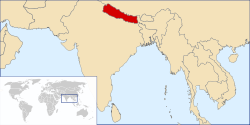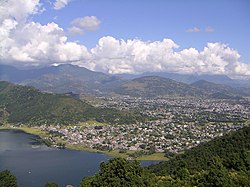| Municipality | |
|---|---|
 | |
| Category | Third-level administrative division |
| Location | Districts of Nepal |
| Found in | Districts |
| Number | 753 (as of 2017) |
| Government | |
| This article is part of a series on |
| Administrative divisions of Nepal |
|---|
 |
| Federal Democratic Republic of Nepal (since 2015) |
|
Nepal Portal Administrative divisions by country |
 |
|---|
|
|
A municipality (Nepali: नगरपालिका) in Nepal is an administrative division in the Provinces of Nepal. The urban population of Nepal refers to the inhabitants residing in the designated municipal area.[1] Population size has been taken as the principal criteria in the declaration of urban areas in Nepal since 1961. Municipalities can therefore also include rural areas.[2] It functions as a sub-unit of a district. Nepal currently has 293 municipalities, which given the 2011 population estimate of 16,656,057.
The municipalities are categorised into three categories: Metropolitan municipality (500,000+ population), Sub-metropolitan municipality (200,000+ population) and Municipality (10,000+ population). There are 6 metropolitan municipality, 11 sub-metropolitan municipality and 276 municipality.[2]
History
[edit]The first urban center in Nepal took place in Kathmandu Valley. The historical evidences on the existence of towns in the Kathmandu Valley are found during Licchavi period. At the same time, three major towns with urban characteristics had been developed in the Kathmandu Valley. During the Rana period, towns in the hills were also as hill stations for the purpose of administration and as an outpost against invaders.[1] Towns like Dhankuta in East Nepal, Palpa in Central Nepal and Doti in West Nepal were initially developed as cantonments. Urban areas in the Terai developed because of trade between Nepal and British India. The British had laid railway lines at the border of Nepal for the purpose of trade which gradually increased urban centers in the Terai. Although urban areas developed during Rana period or before it were not officially recorded. Kathmandu was given the status of municipality in 1930 but was only gazetted in 1953. Dharan was established in 1958 as a fourth municipality of the country
Structure and responsibilities
[edit]As defined by Part 17 of the Constitution of Nepal, the municipalities are governed by a Municipal Executive headed by a mayor. The Municipal Executive consists of the deputy mayor, ward chairpersons elected from each ward in the municipality, and five women members elected by the Municipal Assembly among themselves and three members from the Dalit or other minority communities.[3] Part 18 of the Constitution of Nepal states that the Municipal Assembly hold all legislative powers of the municipality. It consists of the mayor, deputy mayor, ward chairpersons and four ward members elected from each of the wards in the municipality out of which at least two must be a woman. All members of the Dalit or minority communities that was elected to the Municipal Executive must be the members of the Municipal Assembly of the municipality for representing those communities.[4] Part 17 also includes provisions for a Judicial Committee which is headed by the deputy mayor and consists of two other members elected by the Municipal Assembly among themselves.[3] Schedule 8 and Schedule 9 of the constitution deals with powers that the local executive can execute either on its own or concurrently with the federal and the provincial governments.
Classification
[edit]Metropolitan Municipality
[edit]According to the Local Government Operation Act 2017 a metropolitan municipality must have following criteria to get the status of Metropolitan Municipality:[5][2]
- Population: 500,000+
- Annual Income (in NPR): 1,00,00,00,000+
- Infrastructures: Educational institute up to the higher level, medical services, hospitals, transportation facilities, metalled road, communication services, Museum, stadium, assembly hall and exhibition area of international standard. Sufficient recreation places for children and elderly people, Basic water supply and sanitation services. Garbage treatment and management system, Shopping mall, vegetable and fruit market, hotels of international standards. Urban greenery and scenic beauty, etc. as prescribed by government.
Sub-metropolitan Municipality
[edit]A sub-metropolitan municipality must have to fulfill following criteria:[2]
- Population: 200,000+
- Annual Income (in NPR): 25,000,000+
- Infrastructures: higher-level education, medical services, hospitals, transportation facilities, metalled road, basic communication services, Public garden, assembly hall, stadium, gym hall and covered hall of national standard, Basic water supply and sanitation services. Garbage treatment and management system, Market place, animal slaughter houses, human corpses disposal place. Hotel, motel and resorts of tourism standards. Disable friendly and physically accessible infrastructures.
List of Municipalities by the date of establishment
[edit]1953 to 1997
[edit]There were 58 traditional municipalities which were established from 1953 to 1997.[6] (Below given population are prior to reconstruction in 2017. In 2017, more area and population added to given municipality.)
-
Year Municipality Population (2011) 1953 Kathmandu 975,453 1953 Bhaktapur 81,748 1953 Lalitpur 220,802 1953 Birgunj 135,904 1953 Biratnagar 201,125 1953 Bhadrapur 18,164 1957 Tansen 29,095 1959 Rajbiraj 37,738 1959 Butwal 118,462 1958 Dharan 133,082 1962 Ilam 18,633 1962 Janakpur 97,776 1962 Nepalganj 72,503 1962 Pokhara 255,465 1967 Siddharthanagar 63,483 1969 Hetauda 135,745 1976 Birendranagar 85,138 1976 Dhangadhi 101,970 1976 Lahan 33,653 1977 Bheemdatta 104,599 1978 Bharatpur 143,836 1978 Dhankuta 26,440 1978 Ghorahi 62,928 1982 Banepa 24,764 1982 Damak 75,102 1982 Jaleshwar 23,533 1982 Kalaiya 42,826 1982 Dipayal Silgadhi 23,416 1982 Kapilvastu* (renamed as
Taulihawa)30,428 -
Year Municipality Population (2011) 1986 Bidur 26,750 1986 Dhulikhel 14,283 1986 Inaruwa 28,454 1986 Malangwa 25,102 1992 Gaur 34,937 1992 Tulsipur 51,537 1992 Vyas 42,899 1997 Amargadhi 21,245 1997 Baglung 29,360 1997 Bhimeshwar 22,537 1997 Dasharathchand 16,791 1997 Gorkha (Prithvinarayan) 32,473 1997 Gulariya 55,747 1997 Itahari 74,501 1997 Kamalamai 39,413 1997 Khandbari 26,301 1997 Kirtipur 65,602 1997 Lekhnath*
(merged with Pokhara later)58,816 1997 Madhyapur Thimi 83,036 1997 Mechinagar 57,545 1997 Narayan 21,110 1997 Panauti 27,358 1997 Putalibazar 30,704 1997 Ramgram 25,990 1997 Ratnanagar 46,367 1997 Siraha 28,442 1997 Tikapur 56,127 1997 Triyuga 70,000 1997 Waling 24,006
2014
[edit]Total 133 municipalities were established in 2014 in two segments but on 10 March 2017 reconstructed local level body and brought changing in some of municipalities. Some municipality completely disestablished (declined)
- Taplejung (renamed as Phungling)
- Phidim
- Urlabari
- Myanglung
- Bhojpur
- Diktel (renamed as Rupakot Majhuwagadhi)
- Katari
- Sambhunath
- Kanchanrup
- Mirchaiya
- Suryodaya
- Shaniarjun (renamed as Arjundhara)
- Kankai
- Chainpur
- Belbari
- Pathari Shanishchare
- Sundar Dulari
 Declined
Declined - Koshi Haraichha
 Declined
Declined - Rangeli
- Duhabi Bhaluwa ("Bhaluwa" removed later)
- Siddhicharan
- Beltar Basaha (renamed as Chaudandigadhi
- Birtamod
- Hariwan
- Chandrapur
- Gadhimai
 Declined
Declined - Chautara (Chautara Sangachokgadhi)
- Panchkhal
- Nilkantha
- Dhanushadham
- Chhireshwarnath
- Gaushala
- Lalbandi
- Ishwarpur
- Thaha
- Nijgadh
- Khairahani
- Chitrawan
 Declined
Declined - Shuklagandaki
- Bandipur
- Kushma
- Resunga
- Sandhikharka
- Sunwal
- Besisahar
- Gaindakot
- Chapakot
- Rampur
- Kawasoti
- Devachuli
- Bardaghat
- Sainamaina
- Beni
- Lumbini Sanskritik
- Dev Daha
- Tilottama
- Krishnanagar
- Shivaraj
- Kohalpur
- Shaarada
- Mangalsen
- Sanfebagar
- Rajapur
- Pyuthan
- Dullu
- Chandan Nath
- Jayaprithvi
- Lamkichuha
- Attariya (renamed as Godawari)
- Api (renamed as Mahakali)
- Punarbas
- Belauri
- 61 new Municipalities were established on 2 December 2014.[9]
- Gokarneshwor
- Dakshinkali
- Tarakeshwor
- Shankharapur
- Chandragiri
- Kageshwori
- Tokha
- Nagarjun
- Budhanilkantha
- Anantalineshowr
 Declined
Declined - Karyabinayak
 Declined
Declined - Godawari
- Changunarayan
- Maha Manjushree Nagarkot
 Declined
Declined - Patan
- Deumai
- Shivasatakshi
- Letang (renamed as Letang)
- Ramdhuni-Bhasi
- Pakhribas
- Shadanand
- Madi
- Saptakoshi
- Golbazar
- Dudhkunda (renamed as Solududhkunda)
- Badimalika
- Bhajani Trishakti (renamed as Bhajani)
- Parshuram
- Bardibas
- Garuda
- Pokhariya
- Dapcha Kashikhanda (renamed as Namobuddha)
- Melamchi
- Sundarbazar
- Bheriganga
- Musikot
- Palungtar
- Jiri
- Manthali
- Dudhauli
- Ghodaghodi
- Mahagadhimai
- Simraungadh
- Buddhabatika
 Declined
Declined - Ganeshman Charanath
- Mithila
- Sabaila
- Basgadhi
- Madi
- Narayani
 Declined
Declined - Lamahi
- Tripur
 Declined
Declined - Chandani Dodhara (renamed Mahakali)
- Jhalari Pipladi (renamed Shuklaphanta)
- Ramechhap
- Kolhabi
- Mahalaxmi
- Libang (renamed as Rolpa)
- Suryabinayak
- Banganga
- Sanoshree Taratal (renamed as Madhuwan later)
2015
[edit]Total 26 municipalities were established on 19 September 2015.[10] Reconstructed on 10 March 2017 with some changing in existed municipalities.
- Gauradaha
- Laligurans
- Hanumannagar Yoginimai
 Declined
Declined - Sukhipur
- Dhangadhimai
- Bajrabarahi
- Kalika
- Rapti
- Barahathwa
- Bhanu
- Anbu Khaireni
- Madhyabindu
- Bhrikuti
 Declined
Declined - Bhirkot
- Rainas
- Karaputar
 Declined
Declined - Bherimalika
- Chaurjahari
- Bagchaur
- Subhaghat Gangamala (renamed as Gurbhakot)
- Kamalbazar
- Beldandi
- Bedkot
- Krishnapur
- Babai
 Declined
Declined - kalikadevi
2017
[edit]On 10 March 2017 Government of Nepal reconstructed old local level bodies into 744 new local level units as per the new constitution of Nepal 2015.[11][12] Later, on recommendance of Supreme court 9 more local level body added to Province No. 2, increasing from 744 to 753.[13]
- Mai
- Ratuwamai
- Sunawarshi
- Barahkshetra
- Mahalaxmi
- Dharmadevi
- Panchkhapan
- Halesi Tuwachung
- Belaka
- Dakneshwari
- Bodebarsain
- Khadak
- Surunga
- Kalyanpur
- Nagarain
- Bideha
- Haripur
- Haripurwa
- Balara
- Godaita
- Bagmati
- Bahrabise
- Belkotgadhi
- Dhunibeshi
- Bhimad
- Galyang
- Phalewas
- Galkot
- Jaimini
- Dhorpatan
- Musikot
- Buddhabhumi
- Maharajganj
- Sitganga
- Bhumikasthan
- Swargadwari
- Aathbiskot
- Bangad Kupinde
- Barbardiya
- Panchpuri
- Lekbesi
- Chamunda Bindrasaini
- Aathbis
- Chhedagad
- Nalgad
- Thuli Bheri
- Tripurasundari
- Khandachakra
- Raskot
- Tilagufa
- Chhayanath Rara
- Tribeni
- Budhiganga
- Budhinanda
- Bungal
- Panchadewal Binayak
- Shikhar
- Gauriganga
- Melauli
- Purchaudi
- Shailyashikhar
- Karjanha
- Mithila Bihari
- Sahidnagar
- Kamala
- Hansapur
- Aurahi
- Balawa
- Bhangaha
- Loharpatti
- Manara Shiswa
- Matihani
- Ramgopalpur
- Kabilasi
- Madhav Narayan
- Katahariya
- Gujara
- Dewahi Gonahi
- Brindaban
- Baudhimai
- Pacharauta
- Parsagadhi
- Bahudarmai
- Ishnath
- Maulapur
- Paroha
- Phatuwa Bijayapur
- Rajdevi
- Rajpur
- Jeetpursimara
- Hanumannagar Kankalini
- Madhyanepal
- Thakurbaba
- Sundar Haraicha
See also
[edit]References
[edit]- ^ a b "EVOLUTION OF MUNICIPALITIES IN NEPAL: CHALLENGES AND PLANNING". Gopi Krishna Pandey. Retrieved 7 December 2020.
- ^ a b c d "NEPAL URBAN RESILIENCE PROJECT (NURP)" (PDF). Retrieved 7 December 2020.
- ^ a b "Part-17 Local Executive – Nepal Law Commission". Retrieved 2020-12-10.
- ^ "Part-18 Local Legislature – Nepal Law Commission". Retrieved 2020-12-10.
- ^ "स्थानीय-सरकार-सञ्चालन- ऐन" [Local Government Operation Act, 2017] (PDF) (in Nepali). Government of Nepal. 2017. Retrieved 7 December 2020.
- ^ "Population monograph Volume-3" (PDF). Central Bureau of Statistics, Nepal. 2014. Retrieved 7 December 2020.
- ^ "72 new municipalities announced". My Republica.com. Archived from the original on 2014-06-18. Retrieved 2014-06-10.
- ^ "Government announces 72 new municipalities". The Kathmandu Post. Retrieved 2014-06-10.
- ^ "Government announced 61 municipalities". www.kathmandupost.ekantipur.com. 3 December 2014. Retrieved 17 July 2018.
- ^ "Govt declares 26 new municipalities". www.kathmandupost.ekantipur.com. 19 September 2015. Retrieved 18 July 2018.
- ^ "New local level structure comes into effect from today". www.thehimalayantimes.com. The Himalayan Times. 10 March 2017. Retrieved 17 July 2018.
- ^ "New local level units come into existence". www.kathmandupost.ekantipur.com. 11 March 2017. Retrieved 18 July 2018.
- ^ "Govt prepares to add 9 more local levels in Province 2". KMG. 11 August 2017. Retrieved 9 December 2020.





